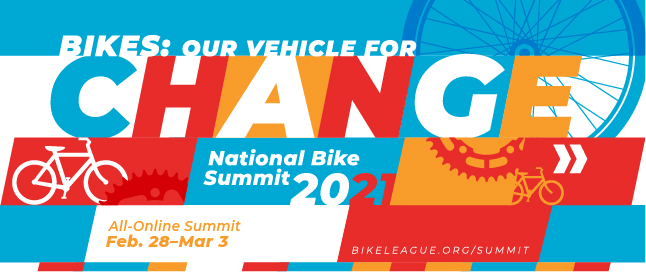- What BikeWalkNC does to improve bicycling
- What to do if you want to get a law passed or change a law
- How to talk to legislators
- WHY SHOULD SUPPORT BIKEWALKNC
- a lot of wonky infrastructure stuff
- and more!
BWNC Is Planning Your 2021 Summit and Your Input Is Critical
Please save November 3-6 for this year’s BikeWalk NC Summit, then take 2 minutes to provide some important information about your travel and convening comfort level and expectations.
The League of American Bicyclists’ National Summit
Pre-Summit Social and Q&A on E-bikes and Cargo bikes with Arleigh Greenwald
Arleigh Greenwald is the owner of Bike Shop Girl Bikes in Aurora, CO. A mom and life long bike industry employee with over 18+ years as a professional mechanic, she has guided many in their purchase of a cargo bike and inspired countless others to “bike more and worry less,” (a philosophy we can all relate to these days). She has a deep desire to make our communities healthier, happier, and less congested as she watches her own children grow up. You can see several of her reviews of cargo bikes at the website bikeshopgirl.com. Arleigh is passionate in believing that ADHD, obesity, transportation gases, and much more can all be helped with a simple bike ride and choosing to #LeaveTheCarAtHome. Grab a beverage, come say hello to everyone, and bring your questions for Arleigh on Weds., November 4. We’ll start gathering at 5:30 pm ET, and Arleigh will join us at 6 pm.
How inclusive is Public Transit for those with disabilities?
How much support is given to non-car forms of transportation in our state?
Before NCDOT’s current financial woes, in 2018-2019, North Carolina’s Department of Transportation had a budget of $5 billion dollars.
From NCDOT’s $5 billion budget, public transit’s share was only $124.5 million for the entire state, which has 90 transit systems. (Note: many of the budget decisions for how NCDOT can spend money come not from NCDOT but from the General Assembly.) This lack of serious financial support makes it impossible to have the type of transit systems that communities ask for.
People often say they don’t take the bus because of the amount of time it takes over driving. Would it be different if buses had more funding, dedicated lanes, and more input from those who depend on them most? And what does the amount of money given to transit say about how our state values those who cannot drive or don’t have access to a car?
The Summit will have a panel discussion that will address several issues related to mobility as it impacts people who are blind or visually impaired or otherwise disabled. With advances in technology, changes in the ways people get around and aging Baby Boomers, increasing numbers of people with disabilities are out and about and engaging in society on all levels. The need for transit and transportation services and infrastructure which will allow for safe and effective travel for school, work, healthcare, social and cultural interactions and engagement has never been more important to the growing community of people with disabilities.
This session will spotlight the needs of those for whom transit is not just an alternative to driving, but a main part of their independence and mobility.
UPDATE: You can watch the discussion below:
